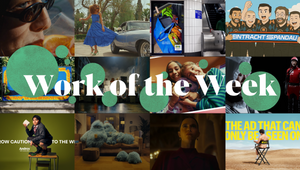
Digital Renaissance: A Divine Trip from Space to a Floating Place

For those of you who just walked in: Sizzer's Digital Renaissance is an effort to revive digging culture and surpass - burst if you must - the bubble created by the age of streaming. Today we drop our third triad of playlists on Spotify in an attempt to broaden your horizon and - above all - make you enjoy some neat tunes.
This edition we will start out in Space to eventually sail homewards and bang the drums on mother Earth. Allow me to elaborate on this phrase / explain the picks!
Sputnik Love
Why curb our desire for expansion to our current planet of residence, if we could also reside in Space?
I will hereby unobtrusively open Sizzer Pluto by putting together a batch of tunes that will make you float the extra-terrestrial void for a proper one hour 43 minutes. Picture it this way: a spaceship is descending above your house, a friendly stranger gets out and approaches you to ask whether he may take twenty records from your collection back into space, to play it for an extra-terrestrial population. What do you hand them? To limit the overwhelming idea of having to choose from 'all' music, I themed the actual music around the subject of space too.
Sputnik 1 launched in 1957, initiating the Space-Age. That being said, we launch our trip with a Sidney Owens & North, South Connection b-side called Sputnik. A beautiful mysterious — somewhat psychedelic-sounding seven inch record from 1976 that will easily cost you a bob or two. By now you should be outside the ether, great job.
Song Of The Second Moon (1959) is next in line. This experimental cut from Tom Dissevelt & Kid Baltan could easily be dubbed a - very, very - proto-piece of left-field electronic music, extremely ahead of its time for sure. Tom Dissevelt was hired in 1956 by Philips in order to develop new ways in music on a scientific base in the natural sciences laboratory. Together with Dick Raaijmakers and other collaborators, he produced electronic experimental music between 1956 and 1963. Dick Raaijmakers flipped his first name and Natlab (Natuurkundig Laboratorium - laboratory for physics) to the more catchy anagram Kid Baltan, which is also very modern sounding for some reason.
By this time you should have surpassed the Moon, well done. We have to be honest, Sun Ra was right: Space Is The Place. Let him take you beyond the beyond and - afterwards - enjoy a meandering mix of other cosmic Jazz, infinite Fuzz, intergalactic Disco, interplanetary Dub, universal Pop, and other galaxy jams that suit your current orbit.
Since you are about to pass Tatooine, I think you should try and fetch a Moof Juice to keep it alien! Next, we set sail to...
Don't Lose The Smooth
Some call it Dad Rock, some purists distinguish AOR (Adult Oriented Rock), the only name that lives up to the game is Yacht Rock - according to Wiki: "a broad music style and aesthetic commonly associated with soft rock, one of the most commercially successful genres from the mid-1970s to the mid-1980s. Drawing on sources such as smooth soul, smooth jazz, R&B, and disco, common stylistic traits include high-quality production, clean vocals, and a focus on light, catchy melodies."
Although this term is generally to be found a bit pejorative, I - for this rare occasion - allow myself to ignore this form of stereotyping, as I thought it was just named after floating the seas with the heaviest ease, never losing the smooth.
An ode to the buttery - mostly - late 70's / early 80's grooves, clustered around the cult of Yacht Rock. For a more in-depth education on the matter, I highly recommend to watch the similarly titled DIY comedy series about it.
For now, I suggest you treat yourself to a cold, yet smooth cocktail with one of those silly little umbrellas, and anchor yourself to the sofa watching the sunset.
Amen, Brother
Washington D.C.’s soul / funk outfit The Winstons should - by now - hopefully ring a bell to those interested in sampling culture, or in music in general, for they could easily be credited as one of the most influential groups in musical history.
In 1968, The Winstons signed to Curtis Mayfield's - then brand new - Curtom Records, where their single Ain't Nothing Like A Little Lovin' failed to gain the attention it deserved, due to distribution difficulties. However, their 1969 single Color Him Father (Metromedia Records) did well at the time - peaking at number seven in the Billboard Hot 100. The Recording Industry Association of America awarded it a gold record (sold over a million copies) and eventually it even won a Grammy. After this small taste of success, the band slowly faded into the shadows and re-appeared to be another group with high potential to be forgotten and shelved somewhere in our brain's auditory cortex.
Or wait what? The single also had a b-side! An instrumental funk cover to US gospel standard Amen called Amen, Brother. It's this cut that makes the band one of the most underrated suppliers of rhythmical backbone to a broad range of musicians after them.
In Amen, Brother, at 1.26 to be exact, drummer G.C. Coleman plays a six second, four-bar drum break - as I read on Wiki: "For two bars, he plays the previous beat; in the third, he delays a snare hit; in the fourth, he leaves the first beat empty, following with a syncopated pattern and early crash cymbal". This short break has been sampled over 5000 times and, as of 2020, Amen, Brother is the most sampled song in music history!
Apart from a crowd-funding campaign in 2015 (grossing £24,000), the band never received official credit, nor money/royalties, and The Winstons were unaware of the widespread use until 1996. One of the earliest uses goes back to 1986 - Salt-N-Pepa's 1986 cut I Desire - and the sample has been used most famously in N.W.A. - Straight Outta Compton, not to forget the song also got sampled on the Futurama theme and dozens and dozens of Jungle / D'n'B records in the 90's.
Coleman died homeless and destitute in 2006, unaware of the impact his drum solo had have. Lead vocalist Richard Lewis Spencer died in 2020, in 2015 he stated: "It's not the worst thing that can happen to you. I'm a black man in America and the fact that someone wants to use something I created - that's flattering." Amen to that.
After starting with the actual song - here's nineteen songs that sampled the infamous b-side. To stay in the holy spirits, I suggest you pour yourself a glass of red wine in loving memory of those responsible for this awesome track.
Jasper Nijland, Music Researcher at Sizzer















